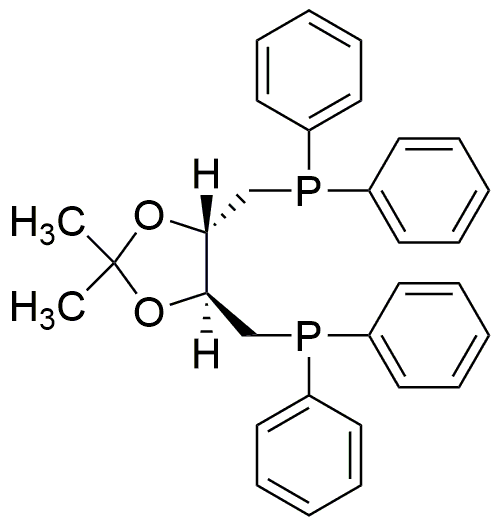(2S,3S)-(+)-1,4-Bis(diphenylphosphino)-2,3-O-isopropylidene-2,3-butanediol is widely utilized in research focused on:
- Catalysis: This compound serves as an effective ligand in various catalytic processes, enhancing reaction rates and selectivity in organic synthesis, particularly in asymmetric reactions.
- Pharmaceutical Development: It plays a crucial role in the development of new drugs, especially in the synthesis of complex organic molecules that are essential for medicinal chemistry.
- Material Science: The compound is used in the formulation of advanced materials, contributing to the development of polymers and composites with improved properties.
- Environmental Chemistry: It is applied in the design of catalysts for environmental remediation processes, helping to break down pollutants more efficiently.
- Research and Development: This chemical is a valuable tool in academic and industrial laboratories for exploring new chemical reactions and mechanisms, aiding in the advancement of chemical knowledge.
General Information
Properties
Safety and Regulations
Applications
(2S,3S)-(+)-1,4-Bis(diphenylphosphino)-2,3-O-isopropylidene-2,3-butanediol is widely utilized in research focused on:
- Catalysis: This compound serves as an effective ligand in various catalytic processes, enhancing reaction rates and selectivity in organic synthesis, particularly in asymmetric reactions.
- Pharmaceutical Development: It plays a crucial role in the development of new drugs, especially in the synthesis of complex organic molecules that are essential for medicinal chemistry.
- Material Science: The compound is used in the formulation of advanced materials, contributing to the development of polymers and composites with improved properties.
- Environmental Chemistry: It is applied in the design of catalysts for environmental remediation processes, helping to break down pollutants more efficiently.
- Research and Development: This chemical is a valuable tool in academic and industrial laboratories for exploring new chemical reactions and mechanisms, aiding in the advancement of chemical knowledge.
Documents
Safety Data Sheets (SDS)
The SDS provides comprehensive safety information on handling, storage, and disposal of the product.
Product Specification (PS)
The PS provides a comprehensive breakdown of the product’s properties, including chemical composition, physical state, purity, and storage requirements. It also details acceptable quality ranges and the product's intended applications.
Certificates of Analysis (COA)
Search for Certificates of Analysis (COA) by entering the products Lot Number. Lot and Batch Numbers can be found on a product’s label following the words ‘Lot’ or ‘Batch’.
*Catalog Number
*Lot Number
Certificates Of Origin (COO)
This COO confirms the country where the product was manufactured, and also details the materials and components used in it and whether it is derived from natural, synthetic, or other specific sources. This certificate may be required for customs, trade, and regulatory compliance.
*Catalog Number
*Lot Number
Safety Data Sheets (SDS)
The SDS provides comprehensive safety information on handling, storage, and disposal of the product.
DownloadProduct Specification (PS)
The PS provides a comprehensive breakdown of the product’s properties, including chemical composition, physical state, purity, and storage requirements. It also details acceptable quality ranges and the product's intended applications.
DownloadCertificates of Analysis (COA)
Search for Certificates of Analysis (COA) by entering the products Lot Number. Lot and Batch Numbers can be found on a product’s label following the words ‘Lot’ or ‘Batch’.
*Catalog Number
*Lot Number
Certificates Of Origin (COO)
This COO confirms the country where the product was manufactured, and also details the materials and components used in it and whether it is derived from natural, synthetic, or other specific sources. This certificate may be required for customs, trade, and regulatory compliance.


